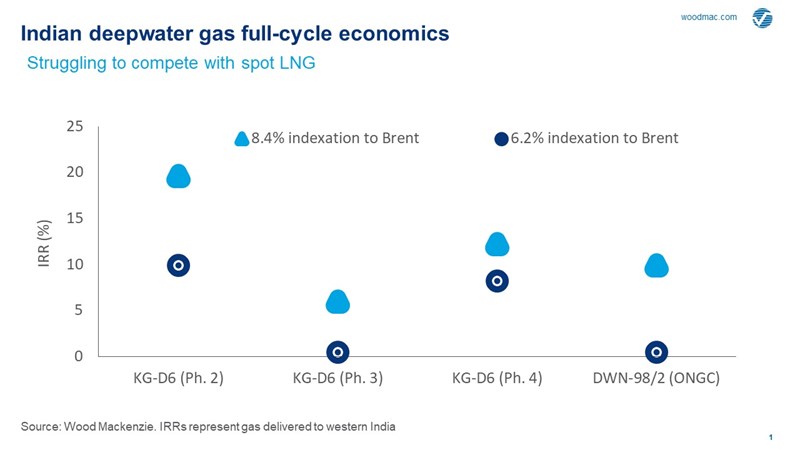LNG is challenging India’s deepwater future
Domestic deepwater holds the key to India’s gas supply over the next five years, but low-cost LNG is putting development in doubt
1 minute read
Gavin Thompson
Vice Chairman, Energy – Europe, Middle East & Africa

Gavin Thompson
Vice Chairman, Energy – Europe, Middle East & Africa
Gavin oversees our Europe, Middle East and Africa research.
Latest articles by Gavin
-
The Edge
A world first: shipping carbon exports for storage
-
The Edge
WoodMac’s Gas, LNG and the Future of Energy conference: five key themes
-
The Edge
Nigeria’s bold strategy to double oil production
-
The Edge
US tariffs – unpredictability is the strategic planners’ nightmare
-
The Edge
Upside pressure mounts on US gas prices
-
The Edge
The coming geothermal age
India’s much heralded Krishna Godavari basin deepwater gas projects will drive domestic gas production growth over the next few years. Combined, the projects will add over 1 bcfd of new supply by 2023. But only a small proportion of this supply has been contracted to date. With India’s gas market shaken by Covid-19, and low spot LNG prices expected to persist at least until 2022, the full commercialisation of these deepwater volumes is at risk.
Which projects are most impacted? How will operators respond? And will India’s notoriously price-sensitive consumers call the shots? To get a better understanding, I spoke with Alay Patel, Principal Analyst, Southern Asia upstream and Vidur Singhal, Senior Analyst Indian gas markets.
How are India’s deepwater developments being impacted?
Deepwater is critical to both the future of India’s upstream sector and to the development of domestic gas markets. Reliance’s KG-D6 and ONGC’s KG-DWN-98/2 projects, off the east coast of India, are behind this growth. KG-DWN-98/2 came online in April while the second phase of the KG-D6 project will start output in late 2020. We project combined incremental output of 400 mmcfd in 2021.
But the full potential of these projects is now less certain. Only 15% of this future supply is currently contracted and India’s gas demand has been hit hard by lockdown measures. Even as demand recovers, deepwater developments will face the competitive threat of persistently low spot LNG prices.
This competition will be strongest through to 2022 as spot LNG prices are expected to remain low. In the key markets of Gujarat and Maharashtra in western India, the delivered price of deepwater gas is now very much in focus.
Read also: India’s new deepwater supply could face pressure from low spot LNG prices
Given low spot LNG prices, is there any hope for deepwater gas?
It’s important to remember that not all deepwater gas is at equal risk. Gas from India’s deepwater fields will clearly have to compete against spot LNG in the major west coast markets but will also be able to access markets in other parts of the country.
Andhra Pradesh and Telangana, for example, while relatively small east coast demand centres, provide advantage for domestic gas. These states do not have LNG import infrastructure and with no competition from spot LNG, sellers need only ensure that gas prices are viable for consumers who can absorb incremental volumes. The city gas distribution, fertiliser and industrial sectors in these states can contribute incremental demand of 350 mmcfd over the next five years.
How are India’s deepwater operators responding?
The two key players here are Reliance and ONGC, and in simple terms Reliance can go lower on price, while ONGC will struggle to compete.
Reliance’s KG-D6 project benefits from better economics than ONGC’s KG-DWN-98/2 project, and the former has already sold an initial tranche of gas at 8.4% indexation to Brent, delivered into western states. However, lower indexation will be required to compete against spot LNG in Gujarat – current import prices are in the range of 6% of Brent.
Reliance looks capable of offering more competitive prices, but ONGC cannot compete at current spot LNG price levels without incurring significant losses. Consequently, ONGC’s gas is at a much higher risk of being replaced by LNG in western markets. Based on Wood Mackenzie’s Brent and spot LNG prices for 2020, Reliance and ONGC will have to go below 6.5% indexation to Brent to match spot LNG prices (delivered to Gujarat).
This lower indexation, even for short-duration contracts, inevitably impacts the returns on these projects. For Reliance, this would push IRRs on phases 2 and 4 down to around 10%, while phase 3 would effectively be zero. For ONGC, the outlook is worse still. Eventually, both operators may also look to defer marketing volumes until the pricing environment improves.
Read more: How will the Asia Pacific upstream sector emerge from the crisis?
So, can we expect India’s gas buyers to opt for spot LNG over domestic gas?
Indian gas buyers are highly price sensitive so spot LNG right now looks hugely attractive. Buyers in India generally preferred oil-linked contracts, which tend to be more transparent and less volatile in comparison to spot LNG prices. However, when prices drop, they increase spot purchases and we expect to see this trend play out over the next couple of years.
There is a clear upside case for LNG and downside risk to deepwater domestic gas in the next two to three years. However, not all volumes are at equal risk and LNG imports won’t have it all their own way. The highly regionalised nature of India’s gas markets, the lack of sufficient regasification and pipeline infrastructure, upstream competitiveness and strategic decisions of buyers will all influence the level of spot LNG that replaces domestic gas. Taking all these factors into account, we estimate that around 35% of uncontracted volumes in 2022 are at a higher risk of being replaced by spot LNG.
Nevertheless, upstream companies are likely to face difficult decisions as they auction their volumes through to 2022: accept lower levels of oil indexation and consequently lower returns, or delay sales (and investment) until prices are more attractive. If they choose to defer, India’s gas production revival story will fail to materialise yet again.
You might be interested in: Are exploration’s days numbered?
Could we see a similar situation elsewhere in Asia?
Absolutely. Take both Myanmar and Vietnam as examples. In both countries, there is clearly now an assumption that as LNG prices are low today, it will be easier and cheaper to develop and import LNG than to develop challenging domestic gas. But I think you can use Myanmar and Vietnam as examples of countries that think LNG is cheap. The lack of fiscal reform only reinforces that, as we have seen with Myanmar. Since the country’s fiscal terms are tough and its fields are deep and remote, we see lower IRRs and limited operator interest in aggressively developing projects.
APAC Energy Buzz is a blog by Wood Mackenzie Asia Pacific Vice Chair, Gavin Thompson. In his blog, Gavin shares the sights and sounds of what’s trending in the region and what’s weighing on business leaders’ minds.







